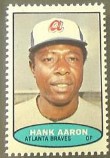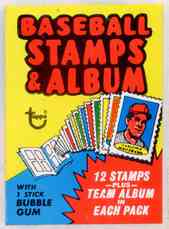Drew Bledsoe - 1998 Playoff Momentum WHITE 'Team Threads' GAME-USED JERSEY
Away Jersey.

Please wander around the website for more info, prices, values & images
on vintage baseball, football, basketball, hockey, sport and non-sports cards.
1970 Topps Baseball Cards |



1974 Topps Stamps |

1971 O-Pee-Chee BaseballAlso referred to as OPC or Topps Canada, most vintage OPC sets were near replicas of the Topps cards from that year. Exactly same in design they usually only differed with the addition of French to the backs and some fronts.To the benefit of collector's OPC made several changes in their 1971 set. The most obvious and useful was a complete redesign of the card backs and the addition of another player photo ! Additionly, over 20 cards were changed including the inclusion of what could be considered the first "Traded" cards. Another difference: Topps cards #202 and #289 were changed to allow the addition of 2 more Expos to the set. The 1971 OPC set is legendary for its short print run, estimated at perhaps just 5% of Topps’ Production. This issue is considered quite elusive, even in Canada. TOP ROOKIE: Steve Garvey TOP STARS: Nolan Ryan, Roberto Clemente, Willie Mays, Hank Aaron, Ernie Banks, Pete Rose, Ted Williams, Thurman Munson, Reggie Jackson, Don Baylor/Dusty Baker RC & MORE !!!
Click for complete
1971 OPC/O-Pee-Chee Baseball checklist and prices
|

Cabinet Card Were oversized trading cards featuring paintings issued mostly 1910-1915.
Card Show is a gathering of dealers & collectors looking to buy/sell/trade sports cards and memorabilia.
Card Stock is the material a card is printed on. Usually paper-based, today companies play with the card stock and sometimes it appears to be wood or leather or see-thru acrylic ...
Cello Pack is a card pack whose wrapper is see-thru plastic. Usually the top & bottom cards are seen. Unopened cello packs showing major stars and rookies sell for heavy premiums.
Centering is the balance of the borders: top/bottom & left/right. On perfectly-centered cards, top/bottom borders match as do the left/right borders. Centering is presented as a set of numbers & directions and often included with the grade. Perfectly-centered is "50/50 t/b" AND "50/50 l/r". As centering gets worse, one number increases and the other decreases. For example: 90/10 t/b is considered extremely off-center top to bottom. The numbers add up to 100 (50/50, 60/40, 90/10 ...).
Certificate Of Authenticity (COA) A document used to verify legitimacy of a collectible. NOTE: Keep in mind that COA's are easier to fake then autographs.
Common A card of a non-star player is considered a "Common" as opposed to cards of a star players or specialty/subset cards such as league leaders, teams cards, World Series cards...
Condition (Grade) Centering, corner wear, photo clarity, edges, creases, print flaws ... all combine to determine a card's condition or grade. Along with rarity/scarcity it is the major factor in a card's value.
Crease Defect usually caused by bending the card. Hard to see, or not, a crease lowers the card's grade (VG or lower) and greatly diminishes it's value.
 NOTE: Your favorite may be on 2 different panels !!!
NOTE: Your favorite may be on 2 different panels !!!  1974 Topps Mini-Albums - seen - perhaps not released.
1974 Topps Mini-Albums - seen - perhaps not released.
